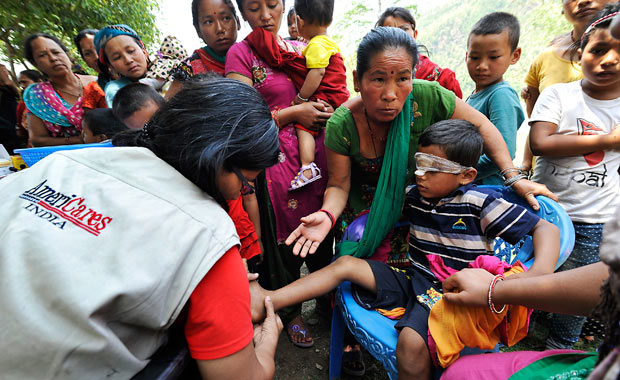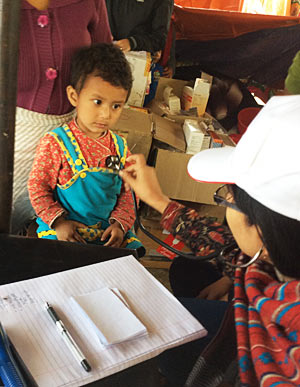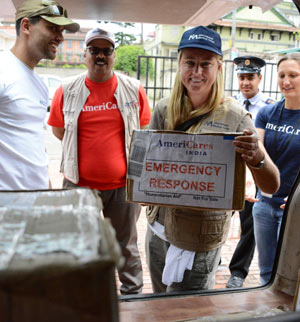In Kathmandu, AmeriCares India continues to receive and distribute more shipments of critically needed medicines and supplies as the organization establishes a longer term presence and implements recovery programs.
The current team of international and local staff followed other medical and support staff led by the first AmeriCares India team that responded within 48 hours to the worst earthquake in Nepal in 80 years. In the immediate disaster response phase, we mobilized medical teams and provided critical medicines and supplies to frontline health workers. Early recovery efforts focus on rebuilding health systems by working with local partners. Programs for health facility repair and mental health services are getting underway.
The 7.8-magnitude earthquake rocked the country, caused buildings to collapse, set off avalanches on Mount Everest and catapulted the entire region into chaos. It struck shortly before noon local time on April 25, centered about 50 miles from Kathmandu and could be felt as far away as New Delhi. More than 100 aftershocks have been recorded throughout the region, with more predicted – hampering rescue operations and terrifying survivors. The most powerful aftershock, a 7.3 magnitude quake more than two weeks after the initial disaster, has added to the death and injury toll.
In the early days, our India medical team treated hundreds of patients through temporary medical camps in Kathmandu and nearby heavily damaged communities, while other team members distributed much needed medicines and supplies to partners on the ground and coordinated relief efforts with inter-agency groups and government authorities.
More air shipments of medical aid arriving in country after the first emergency airlift of 14 tons of medicines and supplies are helping to resupply hospitals, partners and mobile medical teams treating earthquake survivors. To date, more than $20 million in medicines and supplies have been shipped or hand carried to Nepal.
AmeriCares India has been supporting international medical teams on the ground in Nepal helping earthquake survivors. The teams included a special surgical group from India performing more complex surgeries on badly injured survivors. One of our partners, NYC Medics, has treated hundreds of survivors in hard-hit areas of Dhading District.

Dr. Swati Jha of AmeriCares India treats a 7-year-old earthquake survivor’s infected wounds during a medical camp in Arughat, in Gorkha District. Photo by Matthew McDermott
Rising death toll and massive damage
More than 8,600 people are reported to have died in Nepal with thousands more injured. The U.N. estimates that the earthquake has affected 8.1 million people — more than a fourth of Nepal’s population of 27.8 million – with over 2.8 million in need of humanitarian assistance. At least 750,000 homes have been destroyed or damaged, leaving many people homeless. Over 1,100 medical facilities have been severely or totally damaged in the most affected areas, making the need for mobile medical teams, medical tents and supplies even more acute. Shipments of medical tents and general use tarpaulins are underway as the approach of the monsoon season and further damage from aftershocks add to the dangers faced by survivors
Communities outside of Kathmandu at the epicenter of the quake have been devastated and are difficult to access with the damage to roads and infrastructure. The India team was among the first to visit some of these communities to provide immediate medical care.
As our team coordinates relief efforts along with the arrival and distribution of more shipments of medical aid and relief supplies, they are working to maintain health care access while planning to meet longer term needs in rebuilding and strengthening the health sector. We stock emergency medicine and relief supplies in our warehouses in the U.S., Europe and India that can be delivered quickly in times of crisis.
With a commitment to helping Nepal build back better, we draw on our experience in early recovery and longer term rehabilitation programming to inform the next stage of our extended response strategy to restore health services for disaster survivors.
Survivors’ Health Needs

Earthquakes survivors in Nepal are at risk for many health problems. Immediately, thousands of survivors will need medical treatment for cuts, lacerations, crush injuries and broken bones due to collapsing buildings and falling debris. In the following days and weeks, survivors may suffer from wound infections and respiratory problems from inhaling dust. If water supplies are disrupted, as some reports in Nepal indicate, survivors can become ill from drinking unclean water. The most vulnerable people – older people and young children, for example—are at risk for hypothermia and illness from exposure to weather; tens of thousands of survivors are living in tents in Kathmandu as well as in any kind of makeshift shelter in outlying communities, either because their homes were destroyed or damaged or very real threats from continuing aftershocks. Compounding this situation is the approaching monsoon season which will put many of these homeless survivors at even greater risk.
Supplies of trauma and surgical supplies such as scalpels and sutures, IV fluids, antibiotics and other infection control medicine are critical now, as are anesthetics for use during surgery. In the coming weeks, vaccinations against tetanus and measles will be important as survivors often live in crowded conditions. Health workers will also need to help survivors with stress from trauma and loss after this devastating disaster.
Nepal Prone to Quakes
Nepal is prone to earthquakes as it sits atop a thrust fault where the India and Eurasia tectonic plates meet: In 1932, the magnitude 8.0 Nepal-Bihar earthquake killed more than 10,000 people, the most deadly earthquake in Nepal’s history. A magnitude 6.9 quake killed close to 1,500 people in 1988. 
Scientists believe that the 7.8 magnitude April 25 quake was felt by an estimated 105 million people in Bangladesh, India, Nepal, Pakistan and China’s region of Tibet, causing numerous landslides, especially in areas outside Kathmandu with steep slopes. Roads to the Gorkha district, the quake’s epicenter, were blocked by landslides. Many towns and villages have been completely destroyed, and continuing aftershocks are causing more destruction and death.
A week before the quake, 50 earthquake and social scientists had met in Kathmandu to discuss the city’s vulnerability to a massive quake.
